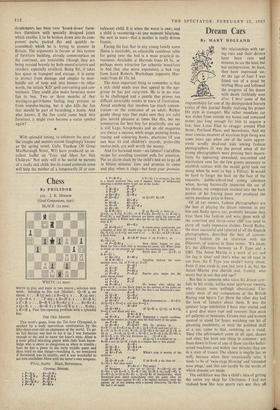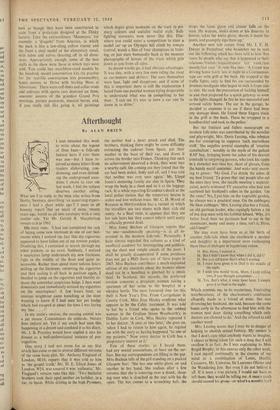Dream Cars
By MARY HOLLAND MY relationships with rac- ing cars and their drivers have been rare and tenuous, to say the least, but not unimpressive. At least, they have impressed me. At the age of four I was fished out of a pond by Stirling Moss and followed the progress of his dance with death faithfully ever after. I bear some of the responsibility for one of the distinguished literary critics of this journal finally realising his proper life style in transport. His rather mundane car was stolen from outside my house and remained stolen just long enough for him to acquire a low, lean Lotus Elan to swagger around Fleet Street, Portland Place, and Snowdonia. And my most concise moment of vicarious high living was some years ago when one of the more aggres- sively scruffy dead-end kids among fashion photographers (it was the period when all the young photographers were proving their mascu- linity by appearing unwashed, uncombed and inarticulate save for the few grunts necessary to establish contact with the model girls) took me along when he went to buy a Ferrari. Its would be hard to forget the look on the face of the exquisite, public-school-tied young salesman when, having laconically inspected the car of his choice, my companion reached into the back pocket of his fraying jeans and produced the entire purchase price in fivers.
Of all car owners, fashion photographers are the best at playing the dream inherent in any low and flashy sports car, probably because they treat them like fashion and wear them with all the contrived and throw-away chic you need to chrry off really expensive clothes. David Bailey, the most successful and talented of all the English photographers, described the best of contem- porary fashion (in an interview with the Observer, of course) in these terms: 'It's tinsel. It's the difference between an E Type and a DB5. The Aston Martin is a work of art and the Jag is tinsel and that's what we all need in our lives. An E Type you needn't worry about. Even if you crash it, you just turn it in, but the Aston Martin you cherish and, frankly, who wants that in our day and age?'
But this is someone who takes his dream sym- bols in his stride, unlike most sports-car owners, who always seem wellnigh obsessional. Cer- tainly most of my companions at the British Racing and Sports Car Show the other day had the look of fanatics about them. It was the quietest large exhibition I have ever visited and a good deal more rapt and reverent than most
art galleries or museums. Grown men and women seemed to stand for hours watching one bit of
gleaming machinery, or even the polished shell
of a car, come to that, revolving on a stand. They (the aficionados) come in all ages, shapes
and sizes, but have one thing in common: put them down in front of one of those toy-like bullet- nosed machines and within two minutes they are in a state of trance. The silence is maybe just as well, because when they occasionally utter it tends to be of 'twin-stage blowing' and 'extended nose plugs,' and this can hardly be the words of which dreams are made.
The exhibition was like a child's idea of getting the entire toy shop for Christmas. I had not realised how like toys sports cars are; they all
look as though they have been constructed to scale from a prototype designed at the Dinky factory. Take the extraordinary 'Mooneyes,' for example, a 'dragster' from America, in which the back is like a low-stung yellow tractor and the front a steel model of the alimentary canal, with tubes and valves shooting off in all direc- tions. Appropriately enough, some of the best stalls in the show were those at which toys were sold. You could buy matchbox-sized models by the hundred. model construction kits (to practise for the real-life construction kits presumably), home movies to 'Drive with Stirling Moss at Silverstone.' There were cuff-links and collar-studs and ashtrays with sports cars depicted on them, souvenir posters of the grandest Grand Prix meetings, picture postcards, musical horns, and, if you really felt like going it, oil paintings which depict great moments on the track in pri- mary colours and socialist realist style. Bull- fighting souvenirs were never like this. Else- where you could enter a competition to steer a model car up an Olympic hill climb by remote control, watch a film of four champions in train- ing, or just stare bemusedly back at the monster photographs of heroes of the track which grin down at you from all sides.
As dream worlds go, it had obvious advantages. It was tiny, with a very few men ruling the roost as car-makers and drivers. The cars themselves were lean, light and dangerous, and if none of this is important there is still the explanation I heard from one puzzled woman trying desperately to understand what was so compelling to her man: 'I can see it's nice to have a car you lie down in to drive.'


































 Previous page
Previous page